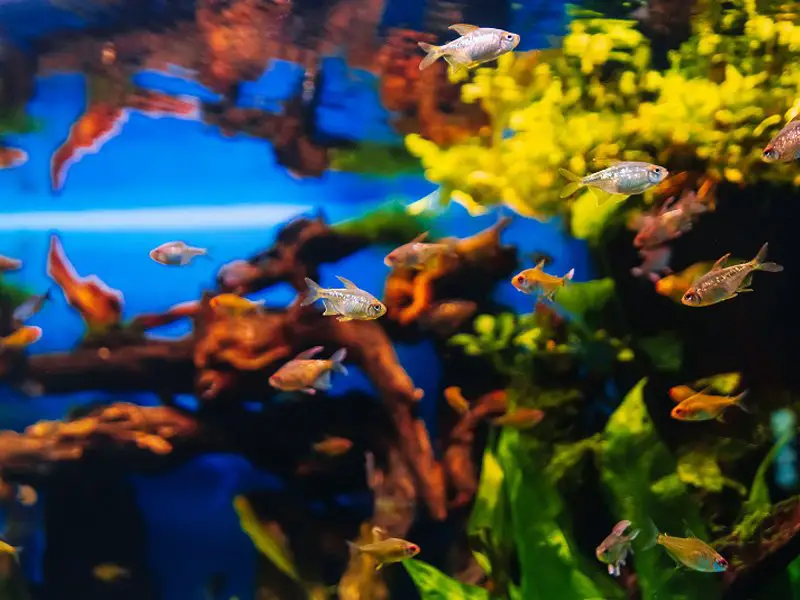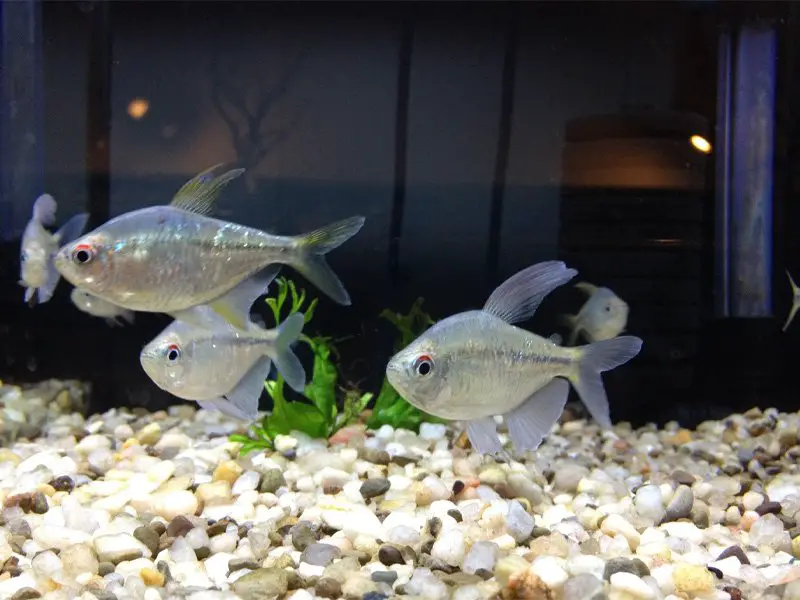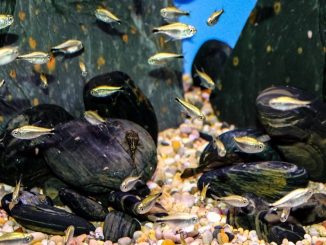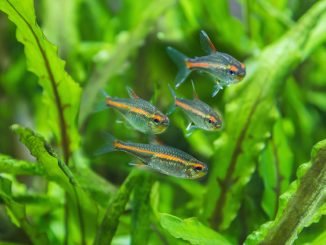
Diamond tetras are freshwater fish of the Characidae family. The fish is often overlooked when it’s young, due to its initially unremarkable appearance. However, as it matures, it sparkles like a colorful diamond.
Diamond tetras are a popular aquarium species because of their calm nature and eye-catching appearance. Like all tetra fish, they are peaceful and resilient. These qualities make them a good option for beginners.
Diamond tetras are compatible with fish of a similar size and temperament.
TABLE OF CONTENTS
Diamond Tetra Facts & Overview

| Category | Rating |
| Care Level: | Beginner |
| Temperament: | Peaceful |
| Color: | Silver, with reflective fins and scales |
| Lifespan: | ~3 to 6 years |
| Size: | ~2.5 inches |
| Diet: | Omnivore |
| Family: | Characidae |
| Minimum Tank Size: | 15 gallons |
| Tank Setup: | Freshwater, plants, caves |
| Compatibility: | Similar sized peaceful fish |
The diamond tetra has many names. Its scientific name is Moenkhausia pittieri. People also call it diamond characin, brilliant smaller, or pittier’s tetra. It’s part of the Characidae family and got the name “diamond tetra’ because its scales refract light like a shimmering diamond.
The diamond tetra comes from South America and originated in Lake Valencia, Venezuela. These days, it also inhabits the Rio Tiquiritu and Rio Bue rivers.
Typically, diamond tetras live in rivers or streams. The species does well in most waters and is best maintained in groups of five or more.
A diamond tetra can live for three to six years. It is a popular fish that you can buy in most pet stores for about $5.
Appearance & Behavior

The diamond tetra is stockier than other tetras. It is also larger. An average adult is about 2 to 2.4 inches in length. Aside from their size, they look like most other tetras, but with some notable exceptions.
Diamond tetras are silver in color. As they mature, their scales become iridescent, meaning that their color changes at different angles. A diamond tetra’s scales can flash several different colors, like blue, green, orange, and even gold.
Its fins are typically semi-transparent with a hint of violet. In common with other tetras, they have a long anal fin.
Female diamond tetras have a short dorsal fin, while males have long, pointed fins. These differences make it easy to identify the sex of each species.
The diamond tetra has striking eyes. The upper half of the eye features a subtle red dash.
A diamond tetra thrives if kept in groups of six or more. It makes a good community fish due to its tranquil temperament. Owners should make sure to give it plenty of vegetation to hide behind.
Diamond tetras can become stressed if they feel exposed, which can cause them to lose their color.
Typical Behavior
Diamond tetras have a placid temperament. They spend their days swimming in groups looking for food. While they occasionally get into playful roughhousing with each other, they won’t cause issues with other fish.
Diamond tetras are a good community fish and mix well with fish of a similar size. This species prefers to live in a school, so keeping them in groups of five or more is ideal.
Diamond tetras are active during the day and will sleep at night. Most aquarists give them around eight hours of darkness at night.
Diamond tetras are peaceful, but they can be semi-aggressive in specific situations. If they feel under threat or stressed, they can nip the fins of other fish. However, owners can avoid this by making them feel secure with other diamond tetras for the company.
These fish are reasonably active and move around a tank with speed. They prefer the middle or bottom of the tank. They enjoy being out in the open in their school, provided there is enough plant to dart behind when they want it.
Some of the best fish to share a tank with diamond tetras are other bottom dwellers, like Corydoras catfish. Additionally, most livebearers such as barbs, catfish, guppies, and zebrafish make good tank mates.
Diamond tetras can be a bad mix with slow swimming fish, as tetras are fast and can easily outcompete slower species for food.
Finally, diamond tetras need their sleep, much like we all do. A timer light with a day/night function can be an excellent choice to help them rest. A dim light suits this fish.
Diamond Tetra Care

Diamond tetras are easy to care for. They are resilient freshwater fish, which makes them suitable for beginners. Diamond tetras thrive in tanks of 15 gallons or more. Additionally, they are happiest in schools of five or more.
Diamond tetras are a great community fish. They prefer low light and lots of aquarium plants to hide behind. A tetra’s natural habitat is shallow streams of warm water with a neutral pH, so a tank of 75°F to 76°F is considered perfect for them to thrive.
These fish are omnivores. You can feed them regular fish food, but they prefer variation, like plant-based food, brine shrimp, and bloodworms.
The diamond tetra is a hardy species. They rarely become ill, and if they do, it’s usually a common freshwater fish illness like worms, skin flukes, or bacterial infections. Good tank maintenance helps keep them healthy.
Following simple guidelines can keep them happy and thriving. Caring for them is easy once you understand and follow some basic practices.
Habitat and Tank Requirements
Diamond tetras were first found in Lake Valencia, in Northern Venezuela. Their natural habitat is shallow, slow-moving streams filled with abundant vegetation and leaf litter. The species thrives in warm waters with a neutral pH.
Pollution and urban growth have caused this beautiful species to become endangered in Venezuela. However, this adaptable fish is bred in the US and is widely available.
Tank Conditions
Diamond tetras are smaller than most freshwater fish. They grow to about 2.4 inches, but they are very active. This activity means that they need a lot of tank space. They also need the company of other diamond tetras.
A tank of 15 gallons is the minimum requirement for three or more of these fish. A diamond tetra school of five or six will thrive in a 25 or 30-gallon tank.
The rough water parameters to aim for are a temperature between 72°F and 82°F, with 75°F to 76°F considered ideal. Just below neutral pH levels of between 6.0 to 7.5 are perfect, with a water hardness of anywhere between 4 to 8 KH.
Diamond tetras love low light and floating plants. Keeping live plants in an aquarium requires sufficient light. A low-output light, such as a low-wattage LED, is best to satisfy both the fish and the plants.
Plants and hiding spots in the tank make this species feel secure. Replicating their natural environment will help them thrive. Diamond tetras are happiest in an Amazonian biotope setup.
The diamond tetra loves a river sand substrate with floating plants. Aquarists can use twisting branches and driftwood to simulate the hiding place of their natural habitat. A black water environment with a darker substrate looks excellent. It will also help highlight the tetra’s sparkling scales.
The diamond tetra does well with a standard filtration system. Canister or hang-on-back models are perfect. Any filtration system you use should be able to cycle the water volume numerous times an hour. This process will help lower nitrate and ammonia levels.
Tank Mates
Diamond tetras are peaceful and are good community fish that are happiest in schools of five or more. They can be kept in big multi-species tanks, but owners need to pick the right tank mates.
Larger or aggressive fish are bad tank mates for diamond tetras, as bigger fish will eat them and cause them stress.
The best tank mates for diamond tetras are fish around their size.
The most compatible tank mates for diamond tetras are:
- Other tetras
- Peaceful bottom-dwellers
- Celestial pearl danios
- Guppies
- Molly fish
Tetras can also be housed with crab, shrimp, or snails.
Diet and Feeding
Diamond tetras are straightforward to feed. They are omnivores and eat any fish food. In their natural habitat, they eat insects and crustaceans, swallowing them whole.
Diamond tetras are fast and aggressive eaters. They can quickly overtake slower fish and eat their share of food. The best diet for diamond tetras includes a mix of frozen, live, and artificial foods like plant-based food, bloodworm, and brine shrimps.
Many aquarists give diamond tetras a plant-based diet. Blanched vegetables like spinach and zucchini make occasional good treats. They also love lettuce. This diet stops the species from eating the aquarium plants when they are hungry.
You should feed diamond tetras two to three times a day. Give them smaller amounts that they can eat within three minutes. They will be happy eating once in the morning and again in the evening.
Disease
Diamond tetras are very resilient fish. They rarely get ill, which makes them great for beginners.
If diamond tetras get sick, it’s usually one of the more common freshwater diseases like:
- Skin flukes
- Ichthyobodo
- Parasitic infestations like worms or protozoa
- General bacterial infections
- Bacterial disease
Tetra owners can avoid these illnesses by keeping their tank water clean and changing 25-50% of the water every two weeks. Good tank maintenance is essential. Anything you add to the tank, like substrate, plants, or decoration, can contain bacteria. Clean each item thoroughly before putting it in the tank.
Diamond tetras become vulnerable to disease when stressed. A well-balanced diet and suitable habitat will mitigate most illnesses.
Breeding

The diamond tetra breeds its young by laying eggs. The species is moderately easy to breed. The most significant difficulty when breeding the diamond tetra is finding compatible pairs.
Each fish needs to be the same size and age. As a result, it can take a few attempts to find a good match. The vast majority of unsuccessful breeding attempts are because of poorly matched pairs.
To get a large number of fry, owners should use a separate spawning tank. A 20-gallon tank at a temperature between 79 to 84° F is recommended. The females need somewhere to deposit eggs, so owners can add java moss or spawning mops. Alternatively, using mesh also works because eggs can fit through, but the parents are kept out.
The best water for breeding diamond tetras has a hardness of 4° dGH or lower. A pH of 5.5 to 6.5 is best. Filtration is essential too. An air-powered filter will do the job.
Diamond tetras can be spawned in single pairs or groups of around six fish of each sex. Many breeders choose to get the fish ready in separate tanks before breeding. This process also involves feeding the fish a diet rich in live foods for a week or more.
From here, owners can transfer an appropriate pair or group into the breeding tank. Breeders pick males that are the most colorful. Female diamond tetras will have rounded bellies when full of eggs.
The best way to induce spawning is to begin with a dark tank and slowly increase the light levels.
Spawning might take a day or two, but sometimes it will happen straight away. The males follow the females around, and once the females release the eggs, the male fertilizes them with sperm.
Once they have spawned, owners should remove the parent to stop them from eating the eggs.
Eggs hatch within 24-36 hours, and the fry start swimming around three or four days later. Fry can eat algae like infusoria for the first few days. After that, feed them brine shrimp, nauplii, or microworms.
Diamond tetra fry grow fast and will soon resemble a small adult. But remember, they won’t develop the coloring of adults for around nine months.
Should You Get a Diamond Tetra for Your Aquarium?
Diamond tetras are beautiful fish. Their glittering scales make them a standout addition to any tank.
They have a peaceful temperament, which makes them excellent community fish, but they mix well with all fish. Bigger, more aggressive species will cause them a lot of stress, while tetras will eat the food of slower swimming fish.
Diamond tetras are easy and straightforward to care for. The species is happiest in schools of five fish or more. They are very active and require a tank of at least 15 gallons.
Diamond tetras are omnivores that benefit from a broad diet. They are moderately easy to breed.
Overall, diamond tetras are beautiful, peaceful fish. They are a hardy species, which makes them an excellent choice for beginner aquarists.








Be the first to comment